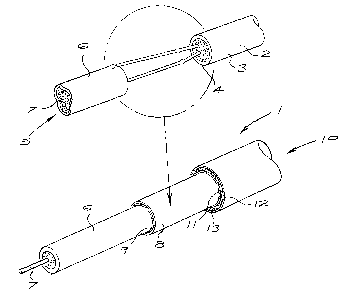Une partie des informations de ce site Web a été fournie par des sources externes. Le gouvernement du Canada n'assume aucune responsabilité concernant la précision, l'actualité ou la fiabilité des informations fournies par les sources externes. Les utilisateurs qui désirent employer cette information devraient consulter directement la source des informations. Le contenu fourni par les sources externes n'est pas assujetti aux exigences sur les langues officielles, la protection des renseignements personnels et l'accessibilité.
L'apparition de différences dans le texte et l'image des Revendications et de l'Abrégé dépend du moment auquel le document est publié. Les textes des Revendications et de l'Abrégé sont affichés :
| (12) Demande de brevet: | (11) CA 2403366 |
|---|---|
| (54) Titre français: | THERMOCOUPLE METALLURGIQUE |
| (54) Titre anglais: | METALLURGICAL THERMOCOUPLE |
| Statut: | Réputée abandonnée et au-delà du délai pour le rétablissement - en attente de la réponse à l’avis de communication rejetée |
| (51) Classification internationale des brevets (CIB): |
|
|---|---|
| (72) Inventeurs : |
|
| (73) Titulaires : |
|
| (71) Demandeurs : |
|
| (74) Agent: | GOWLING WLG (CANADA) LLP |
| (74) Co-agent: | |
| (45) Délivré: | |
| (86) Date de dépôt PCT: | 2000-08-16 |
| (87) Mise à la disponibilité du public: | 2001-02-22 |
| Requête d'examen: | 2003-12-18 |
| Licence disponible: | S.O. |
| Cédé au domaine public: | S.O. |
| (25) Langue des documents déposés: | Anglais |
| Traité de coopération en matière de brevets (PCT): | Oui |
|---|---|
| (86) Numéro de la demande PCT: | PCT/ZA2000/000136 |
| (87) Numéro de publication internationale PCT: | ZA2000000136 |
| (85) Entrée nationale: | 2002-02-08 |
| (30) Données de priorité de la demande: | ||||||
|---|---|---|---|---|---|---|
|
L'invention concerne un thermocouple protégé par une gaine protectrice, constituée des tubes intérieur et extérieur formant un espace annulaire rempli d'un matériau réfractaire fritté à basse température, de préférence sous forme des billes, avant de remplir l'espace, ledit tube extérieur étant étranglé afin de comprimer le matériau. Ce matériau réfractaire comprend du borosilicate et de la poudre d'acide borique.
This invention concerns a thermocouple which is protected by an outer sheath
consisting of inner and outer tubes with the annular space filled with low
temperature sintering refractory material which is preferably beaded before
filling in the space and in which the outer tube is constricted to compact the
material. The refractory material will include borosilicate and boric acid
powder.
Note : Les revendications sont présentées dans la langue officielle dans laquelle elles ont été soumises.
Note : Les descriptions sont présentées dans la langue officielle dans laquelle elles ont été soumises.

2024-08-01 : Dans le cadre de la transition vers les Brevets de nouvelle génération (BNG), la base de données sur les brevets canadiens (BDBC) contient désormais un Historique d'événement plus détaillé, qui reproduit le Journal des événements de notre nouvelle solution interne.
Veuillez noter que les événements débutant par « Inactive : » se réfèrent à des événements qui ne sont plus utilisés dans notre nouvelle solution interne.
Pour une meilleure compréhension de l'état de la demande ou brevet qui figure sur cette page, la rubrique Mise en garde , et les descriptions de Brevet , Historique d'événement , Taxes périodiques et Historique des paiements devraient être consultées.
| Description | Date |
|---|---|
| Inactive : CIB expirée | 2023-01-01 |
| Inactive : CIB expirée | 2023-01-01 |
| Demande non rétablie avant l'échéance | 2007-08-16 |
| Le délai pour l'annulation est expiré | 2007-08-16 |
| Réputée abandonnée - omission de répondre à un avis sur les taxes pour le maintien en état | 2006-08-16 |
| Modification reçue - modification volontaire | 2004-04-01 |
| Lettre envoyée | 2004-01-07 |
| Toutes les exigences pour l'examen - jugée conforme | 2003-12-18 |
| Requête d'examen reçue | 2003-12-18 |
| Exigences pour une requête d'examen - jugée conforme | 2003-12-18 |
| Lettre envoyée | 2002-12-02 |
| Inactive : Page couverture publiée | 2002-11-21 |
| Inactive : Notice - Entrée phase nat. - Pas de RE | 2002-11-15 |
| Demande reçue - PCT | 2002-10-25 |
| Inactive : Transfert individuel | 2002-04-15 |
| Exigences pour l'entrée dans la phase nationale - jugée conforme | 2002-02-08 |
| Demande publiée (accessible au public) | 2001-02-22 |
| Date d'abandonnement | Raison | Date de rétablissement |
|---|---|---|
| 2006-08-16 |
Le dernier paiement a été reçu le 2005-07-19
Avis : Si le paiement en totalité n'a pas été reçu au plus tard à la date indiquée, une taxe supplémentaire peut être imposée, soit une des taxes suivantes :
Les taxes sur les brevets sont ajustées au 1er janvier de chaque année. Les montants ci-dessus sont les montants actuels s'ils sont reçus au plus tard le 31 décembre de l'année en cours.
Veuillez vous référer à la page web des
taxes sur les brevets
de l'OPIC pour voir tous les montants actuels des taxes.
| Type de taxes | Anniversaire | Échéance | Date payée |
|---|---|---|---|
| Taxe nationale de base - générale | 2002-02-08 | ||
| TM (demande, 2e anniv.) - générale | 02 | 2002-08-16 | 2002-02-08 |
| Enregistrement d'un document | 2002-04-15 | ||
| TM (demande, 3e anniv.) - générale | 03 | 2003-08-18 | 2003-06-19 |
| Requête d'examen - générale | 2003-12-18 | ||
| TM (demande, 4e anniv.) - générale | 04 | 2004-08-16 | 2004-07-21 |
| TM (demande, 5e anniv.) - générale | 05 | 2005-08-16 | 2005-07-19 |
Les titulaires actuels et antérieures au dossier sont affichés en ordre alphabétique.
| Titulaires actuels au dossier |
|---|
| TEMPERATURE MANAGEMENT SYSTEMS (PROPRIETARY) LIMITED |
| Titulaires antérieures au dossier |
|---|
| ADRIAN LIONEL GRAY |